
Station Name: NORTH LONSDALE CROSSING[Source:Alan Young]
North Lonsdale Crossing Gallery 1: 1929 - c1954  An oblique aerial photo of North Lonsdale ironworks in 1929 looking north-east. The Bardsea Branch passes in front of the works whilst the Ulverston Canal is seen beyond passing from left to right. The site of North Lonsdale Crossing station, closed since 1916, is seen just above the lower right hand edge of the photo; the signal box and two other small buildings are visible. A train composed of mineral waggons and a brake van stands on the ‘main line’ and further mineral waggons are seen on the ironworks’ sidings. The ironworks was established in the 1870s by the North Lonsdale Iron & Steel Co; iron production continued on the site until 1938 but the company’s foundry remained in use until 1949. In 1945 the Glaxo pharmaceuticals company bought part of the site and progressively developed it, with the last of the ironworks buildings being removed in 1955. In 2019 pharmaceutical are still produced at North Lonsdale by Glaxo-Smith-Klein (GSK).
Copyright photo reproduced from Britain From Above with permision  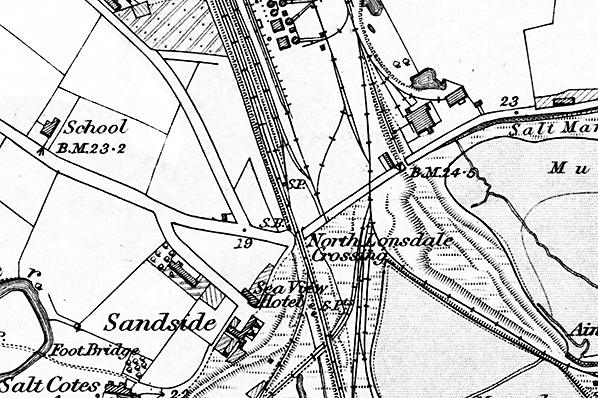
1889 1: 2,500 OS map. Despite opening to passengers in 1888 neither this nor any other large scale OS plan published later seems to have shown the station, although North Lonsdale Crossing itself is named. The station was shown on maps at a smaller scale. The station was immediately north of the crossing where the signal box is shown west of the double track and a small building is shown to the east. North Lonsdale is an important hub for goods and mineral lines. The North Lonsdale Iron & Steel Works lies a short distance north-east of the station and the small settlement of Sandside, including an hotel, is about 100yd south-west with a direct track to the station. Click here for a larger version.
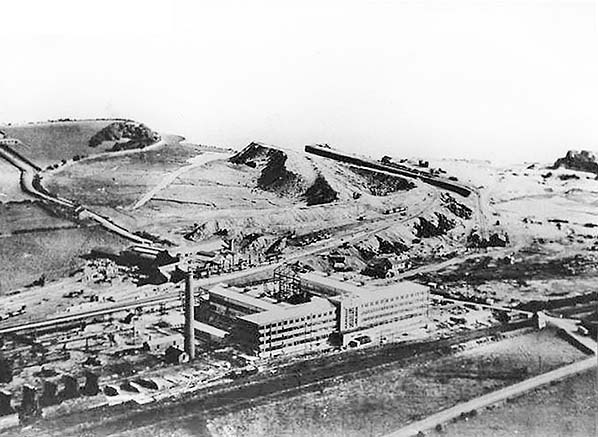
An aerial view of the Glaxo Laboratories under construction in 1948; The Conishead Priory branch is seen running in front of the building with North Lonsdale crossing on the right. The signal box is clearly seen opposite what is assumed to be the former station building.
Photo from John Mann collection 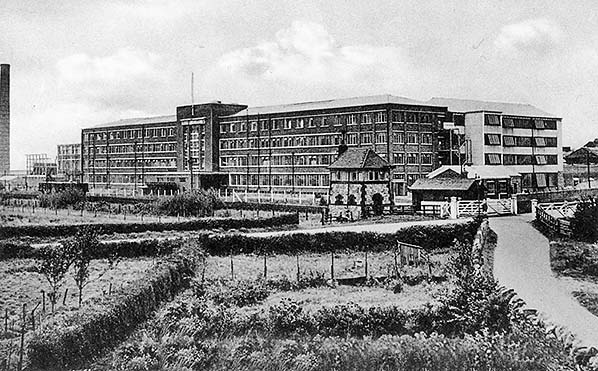 A commercial postcard photograph of the Glaxo Laboratories c1950 looking across North Lonsdale Road. The first buildings of this factory were constructred shortly after the Second World War.The site of North Lonsdale Crossing station is seen immediately left of the level crossing gates. The distinctive signal box is clearly visible and what is probably the station building is to its right: a single-storey structure with a pitched roof.
Photo from John Mann collection 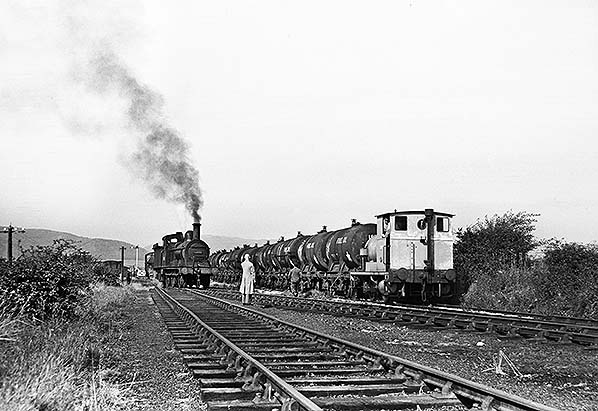
MR Class 2F 0-6-0 No.58199 hands over tanks to Glaxo 0-4-0D between North Lonsdale and Ulverston Canal c1954. In this view looking north the canal towpath level crossing gates are seen in the distance. Ulverston Canal signal box formerly stood to the left of the tracks a short distance before
the crossing gates. Photo by Alan Pearsall courtesy of the Cumbrian Railways Association 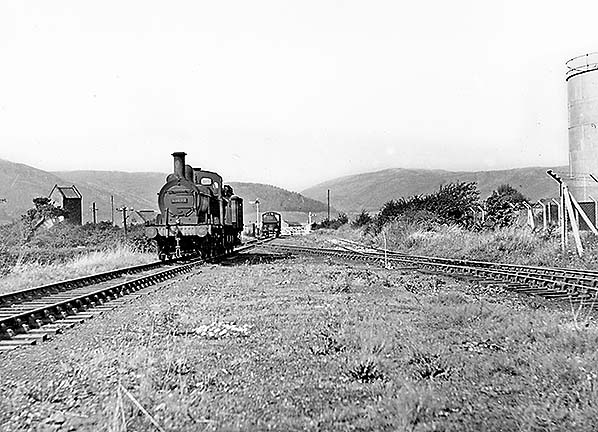
MR Class 2F 0-6-0 No.58199 shunts the sidings near Ulverston Canal, north of North Lonsdale Crossing c1954. The view is to the north with level crossing gates at the Ulverston Canal towpath across the track in the distance. Ulverston Canal signal box closed in 1952 and has been demolished.
Photo by Rev John Jackson courtesy of the Cumbrian Railways Association [JA1118]  North Lonsdale signal box looking north-east c1954. MR Class 2F 0-6-0 probably No.58199 stands in front of the Glaxo pharmaceuticals factory. By this time the box survived only to operate the crossing gates. The masonry of the signal box is worthy of note: the pale rock-faced stone is set against darker ashlar used for the quoins, window architraves and string course. In March 1933 the box closed as a block post with the section of line from Ulverston Canal signal box to North Lonsdale box worked as a siding; this measure was taken when the North Lonsdale ironworks furnaces were out of blast. In November 1937 North Lonsdale box reopened as a block post, as one of the iron works’ furnaces was being fired again, but the furnace closed for good in August 1938; foundry work continued until after World War 2. Thereafter North Lonsdale box was retained to operate the level crossing gates. North Lonsdale signal box looking north-east c1954. MR Class 2F 0-6-0 probably No.58199 stands in front of the Glaxo pharmaceuticals factory. By this time the box survived only to operate the crossing gates. The masonry of the signal box is worthy of note: the pale rock-faced stone is set against darker ashlar used for the quoins, window architraves and string course. In March 1933 the box closed as a block post with the section of line from Ulverston Canal signal box to North Lonsdale box worked as a siding; this measure was taken when the North Lonsdale ironworks furnaces were out of blast. In November 1937 North Lonsdale box reopened as a block post, as one of the iron works’ furnaces was being fired again, but the furnace closed for good in August 1938; foundry work continued until after World War 2. Thereafter North Lonsdale box was retained to operate the level crossing gates.Photo by Alan Pearsall courtesy of the Cumbrian Railways Association [CRA PEA253 Click here for:
|
 North Lonsdale Crossing has been described as a halt, although it opened many years before the suffix was introduced by the Great Western Railway (1903) and the suffix has not been seen on North Lonsdale’s name on official maps or documents. The symbol used on Bartholomew’s 1920 map (published several years after the station had closed) is that used by that company for a halt, but it is simply named as ‘N Lonsdale Crossing’.
North Lonsdale Crossing has been described as a halt, although it opened many years before the suffix was introduced by the Great Western Railway (1903) and the suffix has not been seen on North Lonsdale’s name on official maps or documents. The symbol used on Bartholomew’s 1920 map (published several years after the station had closed) is that used by that company for a halt, but it is simply named as ‘N Lonsdale Crossing’.
 Although its passenger services were minimal and ended early, for many years North Lonsdale was to remain an important location on a goods line that served several industrial sites, and the signal box remained in use. This box opened on 16 June 1883 and was of a striking design used also at Ramsden Dock, Park South and Park North on the Furness Railway. The rock-faced stone walls of the lower part of the box spread gently outwards, giving the structure an impression of strength, and the contrasting smooth red sandstone quoins added dignity. In the timber cabin some of the windows carried shutters instead of glazing. The structure was surmounted by a steep, hipped roof of red slate. In March 1933 the box closed as a block post with the section of line from Ulverston Canal signal box to North Lonsdale box worked as a siding; this measure was taken when the North Lonsdale ironworks furnaces were out of blast. In November 1937 North Lonsdale box reopened as a block post, as one of the iron works’ furnaces was being fired again, but the furnace closed for good in August 1938; foundry work continued until after World War 2. Thereafter North Lonsdale box was retained to operate the level crossing gates.
Although its passenger services were minimal and ended early, for many years North Lonsdale was to remain an important location on a goods line that served several industrial sites, and the signal box remained in use. This box opened on 16 June 1883 and was of a striking design used also at Ramsden Dock, Park South and Park North on the Furness Railway. The rock-faced stone walls of the lower part of the box spread gently outwards, giving the structure an impression of strength, and the contrasting smooth red sandstone quoins added dignity. In the timber cabin some of the windows carried shutters instead of glazing. The structure was surmounted by a steep, hipped roof of red slate. In March 1933 the box closed as a block post with the section of line from Ulverston Canal signal box to North Lonsdale box worked as a siding; this measure was taken when the North Lonsdale ironworks furnaces were out of blast. In November 1937 North Lonsdale box reopened as a block post, as one of the iron works’ furnaces was being fired again, but the furnace closed for good in August 1938; foundry work continued until after World War 2. Thereafter North Lonsdale box was retained to operate the level crossing gates.

 Home Page
Home Page